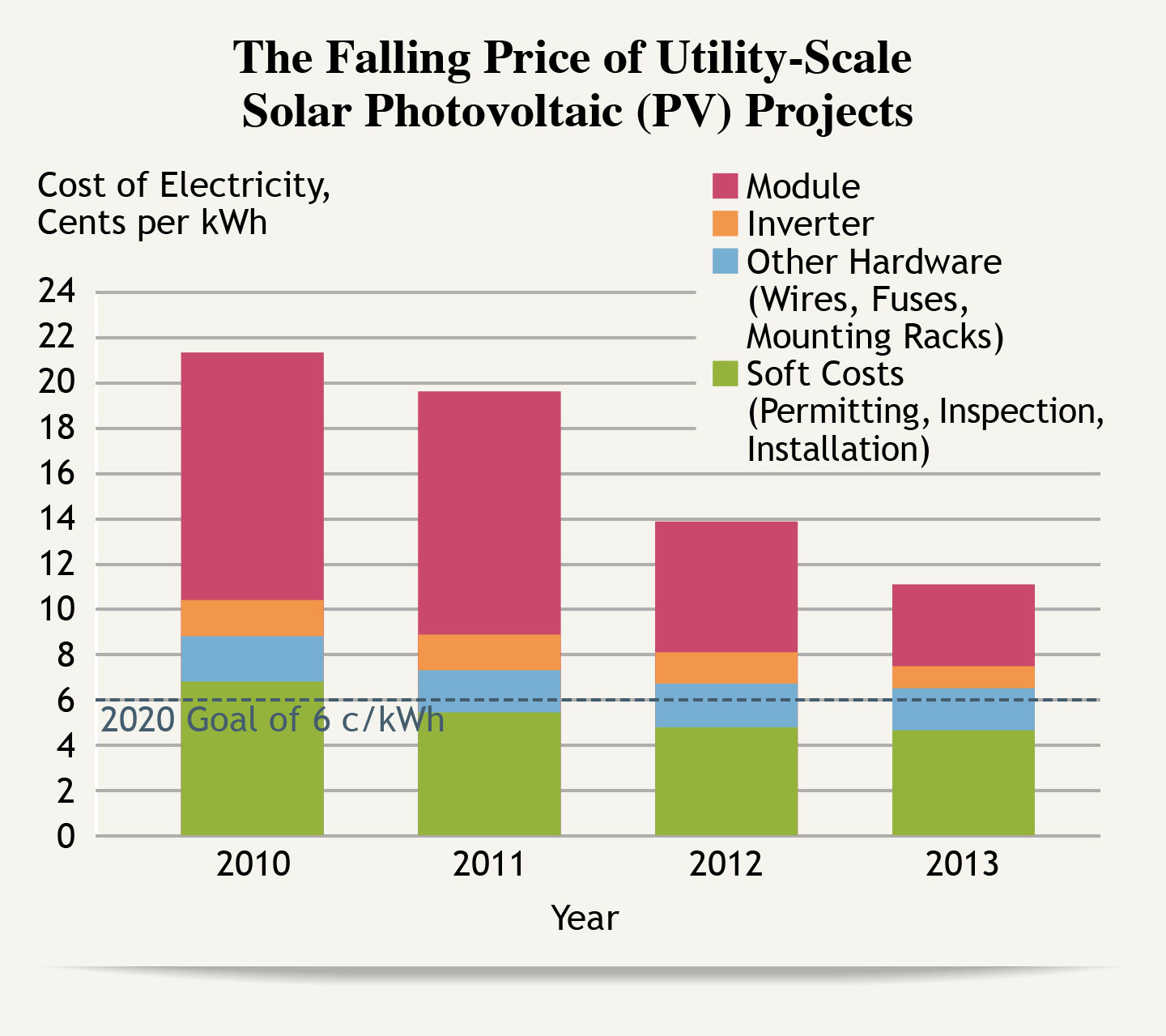Solar
Sunlight is Earth’s most abundant energy source and is delivered free of charge. Indeed, the energy from sunlight reaching the land surface of the United States is thousands of times greater than the country’s current total annual consumption of energy.
Yet harnessing sunlight’s energy content directly—rather than indirectly in fossil fuels, wind, or hydroelectric power—makes only a small contribution to humanity’s energy supply. In 2008, about 0.1% of the electricity consumed in the United States came from solar sources; by 2015, it had risen to 0.6%. In theory, it could be much more. In practice, it will require considerable scientific and engineering progress in the two ways of converting the energy of sunlight into usable forms.
One factor favoring PV systems is that they produce maximum power close to the time of peak demand, which is driven by air conditioning.
Photovoltaic (PV) systems work because PV materials absorb the energy in photons of certain wavelengths and release electrons, which can be collected into a current. Sheets of these materials are routinely employed to power a host of devices—from orbiting satellites to pocket calculators—and many companies make roof-sized units for homes and office buildings.
The current capacity is limited by two factors. One is the efficiency of PV materials: As of 2014, the very best experimental units could convert more than 40% of light energy to electricity; ordinary commercial units are in the range of 5% to 20%. The other is the cost of PV modules. At utility scale, as of 2015 those modules cost about $2 for each watt of generating capacity. (Residential and commercial module price per watt is higher.) That is twice the cost goal set by the U.S. Department of Energy’s (DOE’s) decade-long SunShot program, which began in 2011: $1 per watt capacity in utility-scale systems and a generating cost of $0.06 per kilowatt hour (kWh). That would make PV competitive in price with any energy source—when sunlight is available. Storing that energy would raise the cost.
Progress is encouraging: In 2014, the DOE reported that the program achieved 60% of its long-term goals and that the average price for utility-scale PV electricity dropped from about $0.21 per kWh in 2010 to about $0.11, compared to an average nationwide electricity price of $0.12 per kWh from all sources. In parts of the country, rooftop PV systems are already reaching competitive retail prices. Costs may soon be reduced further by the use of less expensive PV materials—including organic polymers—and efficiency gains.
However, PV is an intermittent source, available only when the Sun is shining. Furthermore, unless PV energy is consumed immediately, it must be stored in batteries or by some other method. Adequate and cost-effective storage solutions await development. One factor favoring PV systems is that they produce maximum power close to the time of peak demand, which is driven by air conditioning. Peak power is much more expensive than average power. With the advent of time-of-day pricing for power, PV power could grow more economical.
Despite the challenges, the DOE estimates that if its SunShot goals can be met, PV systems could supply as much as 14% of America’s electricity by 2030.
Sunlight can also be focused and concentrated by mirrors and the resulting energy employed to heat liquids that drive turbines to create electricity—a technique called solar thermal generation. Unlike PV chips, which only respond to certain wavelengths in sunlight, solar thermal generation uses the entire solar spectrum. Existing systems produce electricity at about twice the cost of fossil-fuel sources. Engineering advances will reduce the cost, but solar thermal generation is unlikely to be feasible outside regions such as the southwestern United States that receive plentiful sunlight over long time periods.
Related topics
Source Material
- Electricity from Renewable Resources: Status, Prospects, and Impediments (2010)
- Effect of U.S. Tax Policy on Greenhouse Gas Emissions (2013)
- Overview and Summary of America’s Energy Future: Technology and Transformation (2010)
- The Power of Renewables: Opportunities and Challenges for China and the United States (2010)
- Hidden Costs of Energy: Unpriced Consequences of Energy Production and Use (2010)
- The Future of Photovoltaic Manufacturing in the United States (2011)


